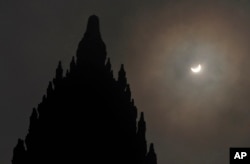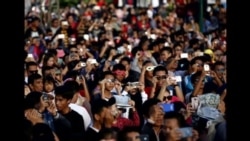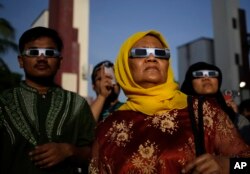Millions of people across the Indonesian archipelago were treated to a rare total solar eclipse Wednesday.
Skywatchers across 12 provinces and three time zones gathered in sports stadiums, planetariums and hilltops as the moon began moving between the Earth and sun shortly after dawn. In many villages along the path of the eclipse, residents kneeled in prayer and held religious rituals as the day turned to darkness during the two-minute stretch of the eclipse.
The event also drew thousands of stargazers from around the world, including a team of scientists from the U.S. space agency NASA, which observed the eclipse from the Maluku islands.
A partial eclipse was also visible across other parts of Asia and Australia, and out into the Pacific Ocean.
The world's last total solar eclipse occurred one year ago this month over Norway's Arctic Svalbard islands. The next full eclipse will take place in August 2017, and will be visible in the United States.
The last time a total eclipse occurred over Indonesia was in 1988. Unfounded fears and misinformation caused panic, with people papering windows and keeping children indoors.
Cloudy skies in parts of Indonesia dampened the spectacle for some. In Palembang, a Sumatran city of more than 1.4 million, thousands of residents from mothers carrying infants to old men gathered at its landmark Ampera bridge from well before dawn. But the total eclipse was only briefly visible if at all.
“Too bad we cannot see when the total solar eclipse occurred, but the dark atmosphere when it happened made us feel happy,” said Palembang resident Martha Sembiring.
Watch video clip of Solar Eclipse
There was also disappointment for a group of six eclipse chasers who traveled from Canada and the U.S. to Kalimantan.
“Unfortunately we got nothing because we had rain showers and solid cloud,” said optometrist Ralph Chou who was hoping to see his 19th total solar eclipse.
Chou, a Canadian who helped develop the international standards for eclipse filters, said there were still impressive effects of light and darkness, and birds appeared confused and disoriented by dark falling again after dawn.
The entire eclipse, which began with the first patch of darkness appearing on the edge of the sun, lasted about three hours.
For the viewer, the length of time the sun was totally eclipsed depended on their location along the path. On land the durations were mostly between 1 and 3 minutes.
In the capital, Jakarta, thousands of residents packed a planetarium at a downtown park where officials distributed about 4,000 filtered viewing glasses that quickly ran out. The eclipse, which from the vantage point of Jakarta produced an impressive crescent, was also streamed on monitors around the planetarium.
Some material for this report came from AP.













